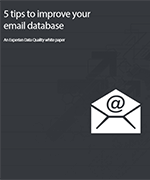Email is the most popular marketing communication channel. On the surface, email marketing seems relatively inexpensive and easy-to-do. However, there are many challenges to fully leveraging the channel.
A very deceiving area is the email marketing database. While it seems like you would just collect emails and then send to them, there are far more complications. Poor email list hygiene can lead to an inability to communicate with subscribers and a poor sender reputation. When this occurs, any investment in the email marketing channel is worthless and can seriously damage the effectiveness of an email marketing program.
In email list hygiene, there are several common mistakes, which include:
- Treating all subscribers the same
- Purchasing email lists
- Letting email addresses go stale and out-of-date
- Failing to collect email addresses on every channel
- Looking at the wrong metrics
If you have been committing one or more of these errors, here are ways to get your email program back on track:
- Treating all subscribers the same
It’s not enough to simply collect email addresses, and throw them in a big list and blast away. Mass generic messages do not work well, and typically lead to high unsubscribe and low click-thru rates.
Solution: Acknowledge and embrace the differences in your list. Implement a segmentation strategy. This can be done based on user persona, product or service interest, signup date, engagement level, etc.
Once you’ve chosen a strategy, create relevant content and engage subscribers in a meaningful way. Strive to build relationships, not one-off opportunities. Remember email can be a two-way, interactive channel.
- Purchasing email lists
Many organizations understand that the email channel delivers ROI. This is why email marketers are often under pressure to constantly grow their email lists. In a pinch, marketers are tempted to turn to third-parties for list acquisition.
Ultimately, this “quick fix” can be disastrous. Purchasing an email list is against email marketing best practices. Why? These lists are chock full of low-quality email addresses that can be harmful for your sender reputation. In short, acquired lists can do more harm than good!
Solution: While purchasing email lists is a quick way to increase list size, it can be detrimental emailing to invalid or undeliverable email addresses.
If you insist on purchasing a list, be sure to follow CAN SPAM laws and approach cautiously.
When emailing on a large scale, permission is always required through an opt-in. If sending one-to-one email messages, keep purchased lists separate from ones you have organically obtained.
- Letting email addresses go stale and out-of-date
Are there old, legacy email lists looming in your database?
About two percent of contact data goes bad each month, including email addresses. In general, the best email addresses are those that engage with your content regularly (opening and clicking emails) and the freshest, meaning the ones that are most recently added to your list.
Do not let your email addresses go cold and inactive. If too much time passes, you cannot count on an email address to be valid and deliverable.
Solution: If you have inactive or old email addresses, look to send a reactivation message or trigger a drip campaign based off the user’s activity.
Before engaging in a reactivation campaign, clean any inactive or old email addresses. This will allow you to identify any invalid email addresses prior to sending and allow you to remove them from your list.
In short, email hygiene is an ongoing process. When done properly, email addresses stay clean and fresh, allowing you to engage immediately and thereafter.
- Failing to collect email addresses on every channel
Email is the top communication channel for marketers and the top data point used to link customer information across channels. It is extremely important that it is collected whenever possible. However, many marketers are either missing the chance to collect email in every channel, or they collect poor quality information that cannot be used.
Solution: Ensure you ask customers to opt-in to email marketing messages in every channel. This means your website, call center, point of sale, etc. This is an easy way to increase your email list with high-quality contacts.
To overcome poor data quality from human error, implement real-time validation to ensure mis-information can be corrected while the consumer is engaged, before the email enters marketing efforts.
- Looking at the wrong metrics
Stop obsessing over just certain email metrics, like open rate and list size! These two metrics will not tell you everything regarding the performance of an email campaign. Understand the significance of all email metrics, especially ones related to deliverability. Otherwise you’re flying blind and may make a big email marketing misstep, like hitting a spam trap or winding up on a blacklist.
Solution: Email marketers oftentimes collect and report performance data, but they rarely analyze it. Leverage internal teams and third-party resources to investigate your data and provide actionable insights.
Remember all the answers lie in your data. It can tell you what’s working and what’s not, so you can replicate the successes and lessen any failed outcomes or potential risks.
Want to know more about email deliverability? Download this white paper to learn:
- Factors that affect your sender reputation score
- Methods for cleansing email addresses
- Steps to improve email database management
Download now






